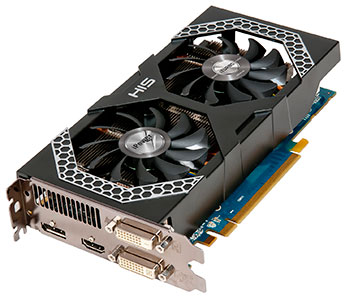 5
5
HIS R7 260X iPower IceQ X² 2 GB Review
Packaging & Contents »Introduction

Alongside the Radeon R9 280X and R9 270X, AMD launched its entry-level Radeon R7 260X graphics card fit for visually-intensive desktops with some mild gaming thrown into the mix. The specifications of the R9 280X and R9 270X may dwarf those of the R7 260X, yet it deserves to be taken seriously from an academic standpoint. The graphics core inside the SoC that drives the Microsoft Xbox One entertainment system isn't all that different from the Radeon R7 260X, at least on paper.

The R7 260X is built around AMD's Bonaire silicon, which we have seen on the company's HD 7790 before. Unlike the HD 7790, it comes with 2 GB of memory and higher clock speeds. Its GPU core is clocked at 1100 MHz (compared to the 1000 MHz on the HD 7790) and memory runs at a scorching 1625 MHz (6.50 GT/s effective), which yields over 100 GB/s of memory bandwidth on even this relatively narrow, 128-bit wide memory bus. The bandwidth is then comparable to what GDDR5-enabled GPUs with 256-bit wide interfaces managed before the 4 GT/s GDDR5 era. The other big difference is in its memory amount: it is now at 2 GB as opposed to the 1 GB on the HD 7790. Based on the 28 nm "Bonaire" silicon, the Radeon R7 260X features 896 stream processors based on the Graphics CoreNext architecture, 56 texture memory units (TMUs), and 16 raster operations units (ROPs).
Today, we are reviewing the HIS Radeon R7 260X iPower IceQ X² using the same clocks and specs as the reference design, though it comes with an improved cooler. The HIS R7 260X iPower IceQ X² is currently available online for $150, which is $10 more than the reference design.
| GeForce GTX 650 Ti | Radeon HD 6870 | Radeon HD 7790 | Radeon HD 7850 | Radeon R7 260X | HIS R7 260X IceQ X² | GeForce GTX 650 Ti Boost | GeForce GTX 660 | Radeon HD 7870 | GeForce GTX 580 | Radeon R9 270X | |
|---|---|---|---|---|---|---|---|---|---|---|---|
| Shader Units | 768 | 1120 | 896 | 1024 | 896 | 896 | 768 | 960 | 1280 | 512 | 1280 |
| ROPs | 16 | 32 | 16 | 32 | 16 | 16 | 24 | 24 | 32 | 48 | 32 |
| Graphics Processor | GK106 | Barts | Bonaire | Pitcairn | Bonaire | Bonaire | GK106 | GK106 | Pitcairn | GF110 | Pitcairn |
| Transistors | 2540M | 1700M | 2080M | 2800M | 2080M | 2080M | 2540M | 2540M | 2800M | 3000M | 2800M |
| Memory Size | 1024 MB | 1024 MB | 1024 MB | 2048 MB | 2048 MB | 2048 MB | 2048 MB | 2048 MB | 2048 MB | 1536 MB | 2048 MB |
| Memory Bus Width | 128 bit | 256 bit | 128 bit | 256 bit | 128 bit | 128 bit | 192 bit | 192 bit | 256 bit | 384 bit | 256 bit |
| Core Clock | 925 MHz | 900 MHz | 1000 MHz | 860 MHz | 1100 MHz | 1100 MHz | 980 MHz+ | 980 MHz+ | 1000 MHz | 772 MHz | 1050 MHz |
| Memory Clock | 1350 MHz | 1050 MHz | 1500 MHz | 1200 MHz | 1625 MHz | 1625 MHz | 1502 MHz | 1502 MHz | 1200 MHz | 1002 MHz | 1400 MHz |
| Price | $130 | $170 | $110 | $130 | $140 | $150 | $130 | $180 | $175 | $310 | $200 |
Jul 12th, 2025 09:29 CDT
change timezone
Latest GPU Drivers
New Forum Posts
- No offense, here are some things that bother me about your understanding of fans. (36)
- Stupid buggy POS Realtek WiFi RTL8852BE (11)
- Swapping existing router w/ a replacement; any issues? (14)
- 'NVIDIA App' not usable offline? (13)
- Chrome has removed uBlock Origin 1.64.0 (remove google search suggestions) (12)
- Share your AIDA 64 cache and memory benchmark here (3097)
- The Official Linux/Unix Desktop Screenshots Megathread (778)
- [GPU-Z Test Build] New Kernel Driver, Everyone: Please Test (90)
- Gigabyte graphic cards - TIM gel SLIPPAGE problem (150)
- NVIDIA App (55)
Popular Reviews
- Fractal Design Epoch RGB TG Review
- Lexar NM1090 Pro 4 TB Review
- Corsair FRAME 5000D RS Review
- NVIDIA GeForce RTX 5050 8 GB Review
- NZXT N9 X870E Review
- Our Visit to the Hunter Super Computer
- Sapphire Radeon RX 9060 XT Pulse OC 16 GB Review - An Excellent Choice
- AMD Ryzen 7 9800X3D Review - The Best Gaming Processor
- Upcoming Hardware Launches 2025 (Updated May 2025)
- Chieftec Iceberg 360 Review
TPU on YouTube
Controversial News Posts
- Intel's Core Ultra 7 265K and 265KF CPUs Dip Below $250 (288)
- Some Intel Nova Lake CPUs Rumored to Challenge AMD's 3D V-Cache in Desktop Gaming (140)
- AMD Radeon RX 9070 XT Gains 9% Performance at 1440p with Latest Driver, Beats RTX 5070 Ti (131)
- NVIDIA Launches GeForce RTX 5050 for Desktops and Laptops, Starts at $249 (119)
- NVIDIA GeForce RTX 5080 SUPER Could Feature 24 GB Memory, Increased Power Limits (115)
- Microsoft Partners with AMD for Next-gen Xbox Hardware (105)
- Intel "Nova Lake‑S" Series: Seven SKUs, Up to 52 Cores and 150 W TDP (100)
- NVIDIA DLSS Transformer Cuts VRAM Usage by 20% (97)